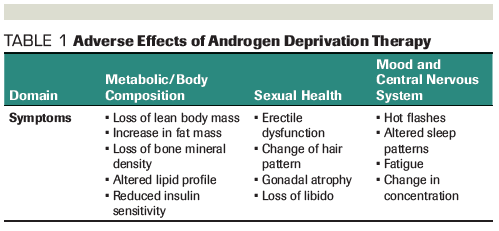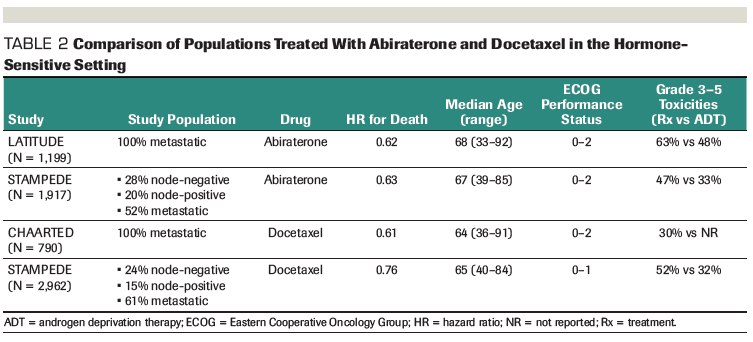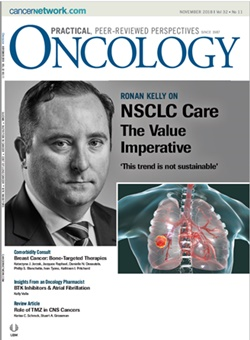Management of Metastatic Prostate Cancer in Frail/Elderly Patients
In this article, we discuss the importance of assessing frail and elderly prostate cancer patients before starting treatment and making adjustments to the choice of therapy, or supportive services, in order to maximize benefit and minimize potential harms.
Oncology (Williston Park). 32(11):570-3.

Elizabeth R. Kessler, MD

Table 1. Adverse Effects of Androgen Deprivation Therapy

Table 2. Comparison of Populations Treated With Abiraterone and Docetaxel in the Hormone-Sensitive Setting

As the world population ages, we can expect to care for an increasing number of older cancer patients. Prostate cancer is inherently a condition that affects patients of advanced age. In caring for these patients who have advanced prostate cancer, it is important to first assess the health status of the patient and his goals of care. As this is established, likely through a geriatric assessment, this will inform how to modify or mold the treatment plan to fit a patient’s needs and vulnerabilities. These vulnerabilities may surface as patients undergo treatment such as androgen deprivation therapy-the backbone of systemic therapy for advanced disease. Androgen deprivation therapy leads to long-term adverse effects; therefore, providers should carefully consider its use and proactively manage toxicity. It is important to assess patients before starting treatment and to adjust the choice of therapy, or supportive services, in order to maximize benefit and minimize potential harms.
Introduction
Prostate cancer is predominantly a disease of the elderly, with peak incidence occurring at just over 70 years old.[1] Given the breadth of prostate cancer and its therapies, this article focuses on advanced hormone-sensitive disease only. This population is increasing as longevity rates rise and more patients present with advanced disease.[2] Most patients with prostate cancer are over the age of 65 years, and are thus considered part of the cancer population of older adults for which there are specific guidelines on care.
Geriatric Assessment
As in any older patient with cancer, one must first define the patient’s general health and fitness with a geriatric assessment. Screening tools, such as the G8, are readily accessible, validated, and referenced in the National Comprehensive Cancer Network Older Adult Oncology guidelines.[3] Screening allows for consideration of how the overall health status of a patient may influence treatment tolerance. Any major findings may lead to a more complete geriatric assessment, which can be performed in conjunction with a geriatric health provider. This approach allows for the identification of patients in whom treatment could cause significant toxicity, or patients who may tolerate therapy if given with additional supportive interventions. By defining a patient’s geriatric health and fitness, the oncology team can adjust the care plan or work with supportive care providers to intervene for areas of vulnerability, such as medication adjustment or mobility therapy.
As part of these initial steps, it is also vital to assess the patient’s goals of therapy and overall priorities. If the patient is not able to participate in these discussions due to cognitive dysfunction, then physicians must speak with the medical decision maker in order to best align care with the patient’s values. The diagnosis of prostate cancer might not be more impactful for some patients than that of a chronic condition. Patients with advanced prostate cancer may still have an estimated life expectancy of 4 to 6 years, and as such, understanding how this diagnosis fits into his overall health picture is paramount. For example, an 83-year-old man in excellent health may have an average life expectancy of 8 to 9 years, while a 73-year-old man in poor overall health may have the same life expectancy. Thus, the initial approach to the care of an older patient with metastatic hormone-sensitive prostate cancer should include an estimate of the patient’s age-matched life expectancy with an adjustment for health status, and how this compares with prognosis due to cancer.
With this preliminary evaluation pooling together the physiologic age of the patient and his ability to participate in care planning, as well as the general goals of such planning, disease biology should also be considered. The sites of metastatic disease, the presence or absence of symptoms, and the rate of disease progression inform the remainder of the care-planning discussion. Overall, patients may be assessed as fit, frail (problems that may be reversible), disabled (nonreversible problems that may be adapted), or so ill that only supportive care should be considered.
Hormone Therapy in Older Patients
The backbone of prostate cancer treatment is hormonal therapy, which aims to limit the activation of the androgen receptor (AR) with testosterone. This limitation of AR activation may occur through agents that decrease circulating testosterone, such as gonadotropin-releasing hormone (GnRH) agonists or antagonists. The use of these agents also decreases testosterone precursors and other off-target effects of testosterone. Agents such as nonsteroidal anti-androgens block AR activation and yet preserve circulating testosterone levels.
Providers must carefully consider the toxicities of androgen deprivation therapy (ADT) in a physiologically older population. These patients have less reserve to absorb additional imbalances or conditions that will impact their current steady state. In general, agents that result in a hypogonadal state can lead to toxicities within the following domains: metabolic and body composition; sexual health; and mood and central nervous system (CNS) symptoms (Table 1).
Metabolic and Body Composition
Patients may experience changes in metabolic parameters and body composition, such as bone mineral density loss and sarcopenic obesity.[4,5] These changes occur naturally through the aging process and are accelerated with the use of ADT. The risk of osteoporosis development is important to keep in mind because geriatric syndromes (such as fall risk, delirium, and incontinence) can predispose patients to osteoporotic fractures. Men who suffer an osteoporotic fracture have a higher mortality risk compared with women.[6,7] As such, preventing bone mineral density loss may in turn prevent a fracture and the associated morbidity and mortality risk of such an event. In order to modify this risk, all patients on ADT should take a daily vitamin D and calcium supplement and engage in weight-bearing exercise.
Older patients with prostate cancer who have been initiated on ADT should also undergo baseline bone mineral density testing and should strongly consider bone-modifying agents, as appropriate, to avoid the development of osteoporosis. Providers may also use the Fracture Risk Assessment Tool (FRAX) score, which estimates the 10-year risk of any fracture and specifically hip fractures based on multiple variables.[8] Men should be offered an additional bone-modifying treatment (ie, bisphosphonate therapy) if their FRAX scores include a 10-year risk of hip fracture ≥ 3% or a 10-year estimated risk of major osteoporotic fracture ≥ 20%. There are no data to support the use of bone-modifying agents in the treatment of prostate cancer; in the hormone-sensitive setting, these are primarily used as agents to prevent osteoporosis.
Soft-tissue body composition may also change as patients gain fat mass and lose muscle mass-known as sarcopenic obesity-on ADT. In community-dwelling older patients, sarcopenic obesity has been linked to increased risk of morbidity and mortality.[9] The loss of lean body mass impacts balance and mobility, such that these patients may be at increased risk of falls or trouble completing their activities of daily living. It has been noted that these body composition and balance changes can occur as early as 3 months after therapy begins.[10] In order to maintain functional independence, providers should strongly consider referral for prehabilitation or have a low threshold for referral to a cancer rehabilitation program. Patients highly value preservation of functional independence,[11] so proactively enlisting additional supportive care services is suggested in order to avoid declines while on therapy.
Additionally, patients may experience metabolic consequences, such as decreased insulin sensitivity, elevated cholesterol levels, and hypertension, which contribute to an increased risk of metabolic syndrome and cardiovascular disease in this population. There are no consistent data linking ADT as a causal agent to cardiovascular disease and mortality. However, there are clear relationships between the metabolic changes that occur on ADT and their contribution to cardiovascular disease development.[12] Further analysis is likely needed to better understand different inflammatory responses to ADT. Prospective investigations have not shown a difference in cardiovascular event rates with GnRH agonists vs antagonists. However, a pooled retrospective analysis has shown a difference in the incidence of cardiovascular events between GnRH agonists and antagonists.[13] This warrants further investigation and could be considered in patients with a high risk of cardiovascular events who would benefit from systemic therapy.
Mood and CNS Effects
Other adverse reactions involve changes in mood, cognition, sleep patterns, and vasomotor skills.[14,15] The relationship between use of ADT and cognition requires clarification, but patients do report changes in emotion regulation and focus. These changes are significant in a population already at risk for cognitive decline, and they considerably impact a patient’s ability to function independently. Patients may also experience labile mood and depressive symptoms that could alter quality of life.[16] In addition, use of ADT can contribute to sleep disturbances, in a population already affected by urgency and nocturia in conjunction with the aging-related changes to sleep patterns. This may worsen mood, focus, and function. There are supportive medications that can be used, but should be looked at with caution in an older population sensitive to medication changes. Avoidance of polypharmacy and consideration of altered metabolism of pharmacologic agents are basic tenants of geriatric medicine.
Alterations in the ADT Prescription
Large studies have supported the use of continuous ADT, as opposed to intermittent dosing, in the treatment of metastatic prostate cancer. However, follow-up meta-analyses have opened the door for use of intermittent ADT therapy,[17] which may improve quality of life and decrease the risk of resultant long-term toxicities for individual patients. Improved knowledge of these toxicities has caused providers to rightly consider the potential benefit and harms prior to prescribing ADT. ADT is a highly effective therapy and should not be ignored for patients who may benefit. In patients with limited life expectancy, in which quality of life is prioritized above longevity, consider the use of intermittent ADT. In addition, patients too frail to tolerate standard
testosterone-lowering treatment may undergo treatment with nonsteroidal anti-androgen monotherapy. This treatment is inferior to continuous ADT in terms of survival outcomes,[18] yet is active enough to potentially offer some short-term disease control or palliation of symptoms. In some patients, the risk of loss of muscle mass or potential cognitive changes on ADT may outweigh the potential benefit of therapy, and single-agent anti-androgen therapy might be considered. Other options include monthly dosing of ADT in order to monitor toxicity and to allow a quicker potential recovery of testosterone if treatment must be interrupted due to side effects. These decisions to alter the standard course of ADT should be carried out in conjunction with the patients and their supportive network. Considering patient priorities when discussing the potential risks and benefits of these approaches is necessary, as with any important medical decision.
Addition of Other Therapies in the Hormone-Sensitive Setting
Docetaxel
As in many other malignancies, we have learned that combination therapy at the outset of treatment improves long-term disease control and survival outcomes. Both docetaxel and abiraterone acetate in the hormone-sensitive setting have demonstrated a survival benefit when added to standard ADT (Table 2). Based on these data, most providers should offer, or at least consider, additional therapies to treat patients at this stage. Certainly in a frail patient population, one must continue to assess the overall fitness of a patient. Any patient already thought of as fit should be offered unaltered therapy. Those found to be vulnerable or frail could be considered based on the ability to reverse at-risk conditions.
Two large studies have evaluated the use of docetaxel and found a survival benefit in those with high-volume metastatic disease.[19,20] These studies enrolled patients in their mid-60s, representing a slightly younger, more fit population than a “real-world” patient. Templeton et al have investigated the use of docetaxel in a real-world setting[21] and found increased toxicities in comparison with the registry trials[19,20]; additional data suggest an increased incidence of febrile neutropenia if docetaxel is used prior to the development of castrate levels of testosterone.[21,22] In many cases, patients on clinical trials do not reflect the patient population we see in the clinic, especially in the case of older adults. In order to help navigate this, a geriatric screen and the use of a chemotherapy toxicity calculator, such as that validated by Hurria et al,[23] can provide useful information in estimating the potential for toxicity due to chemotherapy. Many older men with prostate cancer tolerate chemotherapy, but it is important to maximize pretreatment planning.
Abiraterone acetate and prednisone
Recent data support the use of abiraterone acetate for the treatment of metastatic hormone-sensitive prostate cancer.[24,25] This agent inhibits the adrenal production of androgens, and as such, further decreases available testosterone for AR activation. The use of abiraterone acetate has significantly improved overall survival, with tolerable side effects.[24,25] Abiraterone has been approved by the US Food and Drug Administration for the treatment of metastatic castration-resistant disease, and evaluation of the geriatric cohorts in a registry trial revealed excellent efficacy and tolerability.[26] This post-hoc analysis of fit patients in the chemotherapy-naive setting looked at differences in efficacy and toxicity among patients older (346 patients) and younger (736 patients) than 75 years old. Among the patients over 75 years old treated with abiraterone acetate plus prednisone, the survival benefit was similar compared with the younger group. Of note, the study enrolled patients with an Eastern Cooperative Oncology Group (ECOG) performance status score of 0 or 1 (a fairly fit population). One must recall that the ECOG score is fairly insensitive in older adults, and thus may overestimate their functional status and fitness for therapy.[27] The geriatric screen may help identify areas of disability not uncovered with the ECOG score.
The patients enrolled in the LATITUDE and STAMPEDE-abiraterone trials were generally older (median age, 67 years; range, up to 85 years in STAMPEDE), with ECOG scores of 0–2 compared with the CHAARTED and STAMPEDE-chemotherapy cohorts. Of note, patients being treated with abiraterone must take a low-dose corticosteroid to avoid mineralocorticoid excess, which results from alteration of adrenal function. In addition, patients may not have the means to pay for this costly agent, since older patients usually have a fixed income. Overall, there is little need for dose interruptions or reductions of abiraterone, and it should be considered for a broad group of older patients with newly diagnosed metastatic hormone-sensitive prostate cancer.
Summary
In summary, the first steps in care planning for older patients with prostate cancer are the most crucial. A thorough assessment of a patient’s cognitive function, goals of therapy, and geriatric health through a geriatric assessment will guide decision making. The use of supportive therapy early after the initiation of ADT may decrease loss of functional independence and cognition. The treatment of advanced prostate cancer is likely to continue to change with ongoing exploration of additional agents; these should be offered to fit older men, and considered in those with some vulnerabilities.
Financial Disclosure: Dr. Kessler received study sponsorship for an investigator-initiated trial from Astellas.
References:
1. Siegel RL, Miller KD, Jemal A. Cancer statistics, 2018. CA Cancer J Clin. 2018;68:7-30.
2. Hu JC, Nguyen P, Mao J, et al. Increase in prostate cancer distant metastases at diagnosis in the United States. JAMA Oncol. 2017;3:705-7.
3. National Comprehensive Cancer Network. NCCN guidelines on older adult oncology. https://www.nccn.org/professionals/physician_gls/pdf/senior.pdf. Accessed October 11, 2018.
4. Berruti A, Dogliotti L, Terrone C, et al. Changes in bone mineral density, lean body mass and fat content as measured by dual energy x-ray absorptiometry in patients with prostate cancer without apparent bone metastases given androgen deprivation therapy. J Urol. 2002;167:2361-7.
5. Smith MR, Lee H, Fallon MA, et al. Adipocytokines, obesity, and insulin resistance during combined androgen blockade for prostate cancer. Urology. 2008;71:318-22.
6. Dionyssiotis Y, Dontas IA, Economopoulos D, et al. Rehabilitation after falls and fractures. J Musculoskelet Neuronal Interact. 2008;8:244-50.
7. Jacobsen SJ, Goldberg J, Miles TP, et al. Race and sex differences in mortality following fracture of the hip. Am J Public Health. 1992;82:1147-50.
8. World Health Organization. WHO fracture risk assessment tool. http://www.shef.ac.uk/FRAX/. Accessed August 21, 2018.
9. Batsis JA, Mackenzie TA, Barre LK, et al. Sarcopenia, sarcopenic obesity and mortality in older adults: results from the National Health and Nutrition Examination Survey III. Eur J Clin Nutr. 2014;68:1001-7.
10. Smith MR, Finkelstein JS, McGovern FJ, et al. Changes in body composition during androgen deprivation therapy for prostate cancer. J Clin Endocrinol Metab. 2002;87:599-603.
11. Hurria A, Li D, Hansen K, et al. Distress in older patients with cancer. J Clin Oncol. 2009;27:4346-51.
12. Levine GN, D’Amico AV, Berger P, et al. Androgen-deprivation therapy in prostate cancer and cardiovascular risk: a science advisory from the American Heart Association, American Cancer Society, and American Urological Association: endorsed by the American Society for Radiation Oncology. CA Cancer J Clin. 2010;60:194-201.
13. Albertsen PC, Klotz L, Tombal B, et al. Cardiovascular morbidity associated with gonadotropin releasing hormone agonists and an antagonist. Eur Urol. 2014;65:565-73.
14. Alibhai SM, Timilshina N, Duff-Canning S, et al. Effects of long-term androgen deprivation therapy on cognitive function over 36 months in men with prostate cancer. Cancer. 2017;123:237-44.
15. Nead KT, Gaskin G, Chester C, et al. Association between androgen deprivation therapy and risk of dementia. JAMA Oncol. 2017;3:49-55.
16. Lee M, Jim HS, Fishman M, et al. Depressive symptomatology in men receiving androgen deprivation therapy for prostate cancer: a controlled comparison. Psychooncology. 2015;24:472-7.
17. Magnan S, Zarychanski R, Pilote L, et al. Intermittent vs continuous androgen deprivation therapy for prostate cancer: a systematic review and meta-analysis. JAMA Oncol. 2015;1:1261-9.
18. Kolvenbag GJ, Nash A. Bicalutamide dosages used in the treatment of prostate cancer. Prostate. 1999;39:47-53.
19. Sweeney CJ, Chen YH, Carducci M, et al. Chemohormonal therapy in metastatic hormone-sensitive prostate cancer. N Engl J Med. 2015;373:737-46.
20. James ND, Sydes MR, Clarke NW, et al. Addition of docetaxel, zoledronic acid, or both to first-line long-term hormone therapy in prostate cancer (STAMPEDE): survival results from an adaptive, multiarm, multistage, platform randomised controlled trial. Lancet. 2016;387:1163-77.
21. Templeton AJ, Vera-Badillo FE, Wang L, et al. Translating clinical trials to clinical practice: outcomes of men with metastatic castration resistant prostate cancer treated with docetaxel and prednisone in and out of clinical trials. Ann Oncol. 2013;24:2972-7.
22. Tsao CK, Galsky MD, Oh WK. Docetaxel for metastatic hormone-sensitive prostate cancer: urgent need to minimize the risk of neutropenic fever. Eur Urol. 2016;70:707-8.
23. Hurria A, Mohile S, Gajra A, et al. Validation of a prediction tool for chemotherapy toxicity in older adults with cancer. J Clin Oncol. 2016;34:2366-71.
24. James ND, de Bono JS, Spears MR, et al. Abiraterone for prostate cancer not previously treated with hormone therapy. N Engl J Med. 2017;377:338-51.
25. Fizazi K, Tran N, Fein L, et al. Abiraterone plus prednisone in metastatic, castration-sensitive prostate cancer. N Engl J Med. 2017;377:352-60.
26. Smith MR, Rathkopf DE, Mulders PF, et al. Efficacy and safety of abiraterone acetate in elderly (75 years or older) chemotherapy naive patients with metastatic castration resistant prostate cancer. J Urol. 2015;194:1277-84.
27. Repetto L, Fratino L, Audisio RA, et al. Comprehensive geriatric assessment adds information to Eastern Cooperative Oncology Group performance status in elderly cancer patients: an Italian Group for Geriatric Oncology Study. J Clin Oncol. 2002;20:494-502.
28. Mulders PF, Molina A, Marberger M, et al. Efficacy and safety of abiraterone acetate in an elderly patient subgroup (aged 75 and older) with metastatic castration-resistant prostate cancer after docetaxel-based chemotherapy. Eur Urol. 2014;65:875-83.
